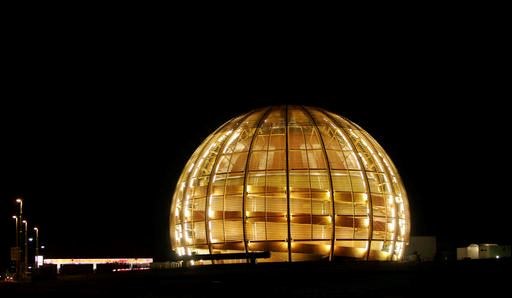 |
| In this March 30, 2010 file picture the globe of the European Organization for Nuclear Research, CERN, is illuminated outside Geneva, Switzerland. (AP Photo/Anja Niedringhaus, file) |
BERLIN (AP) — Scientists have used a laser to tickle atoms of antimatter and make them shine, a key step toward answering one of the great riddles of the universe.
Theory predicts that the Big Bang produced equal amounts of matter and antimatter. Since they cancel each other out, scientists have been trying to find out why a relatively small amount of matter remained — allowing the stars, planets and ultimately life as we know it to come about — and antimatter vanished.
It took researchers at the European Organization for Nuclear Research, or CERN, decades to figure out how to create an antimatter version of the most basic atom — hydrogen — and trap it for long enough to perform tests.
In a paper published online Monday by the journal Nature, they reported the first cautious result from an experiment with antihydrogen. It turns out that when it's stimulated with a laser, antihydrogen appears to produce light on the same ultraviolet frequency as its nemesis in the world of matter, hydrogen.
Adding energy — in this case with a laser — to atoms to see what light they absorb and emit is known as spectroscopy. It is a commonly used tool in physics, chemistry and even astronomy, to determine the atomic composition of substances in a lab or even far-away galaxies. The results can be presented as rainbow-like panels or as graphs showing the distribution of certain colors.
"What we have is one color," said Jeffrey Hangst, a leading member of the team working on the ALPHA experiment at CERN , which is located on the Swiss-French border. "But it's kind of the most fundamental one because it's the one that we can measure most accurately."
Hangst and his colleagues now plan to refine the experiment, using techniques developed for hydrogen over the past 200 years, to map in precise detail the atomic spectrum of antihydrogen.
"All we've done so far is find the top of the hill, now we want to measure the shape of the hill," he told The Associated Press.
Guido Drexlin, a physicist at the Karlsruhe Institute of Technology who wasn't involved in the study, said scientists had been eagerly awaiting the results of the CERN experiment for years. "They are on a good track," he said.
Successfully discovering a difference between matter and antimatter would be worthy of a Nobel Prize, said Drexlin. "The differences between matter and antimatter are extremely subtle," he said. "There is a slight preference for matter and we would like to know why."
Hangst, who is also at Aarhus University in Denmark, said the team at CERN is working on new experiments, including one that looks at how antihydrogen is affected by gravity.
"We're going to make a machine that's vertical, and then we're going to trap antihydrogen and drop it," he said.
One of the great hurdles for researchers is the fact that producing antihydrogen is still a painstaking process that yields just over a dozen atoms each time.
But Hangst said the team has come a long way since it proposed the experiment some 20 years ago, including in the eyes of some peers.
"There was a time when this was kind of the lunatic fringe of physics," he said.
Copyright 2016 The Associated Press. All rights reserved.
This material may not be published, broadcast, rewritten or redistributed.
Page created on 12/21/2016 3:57:34 PM
Last edited 12/21/2016 3:57:34 PM

